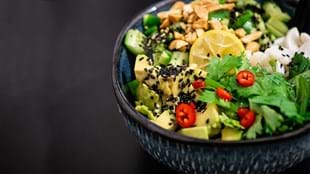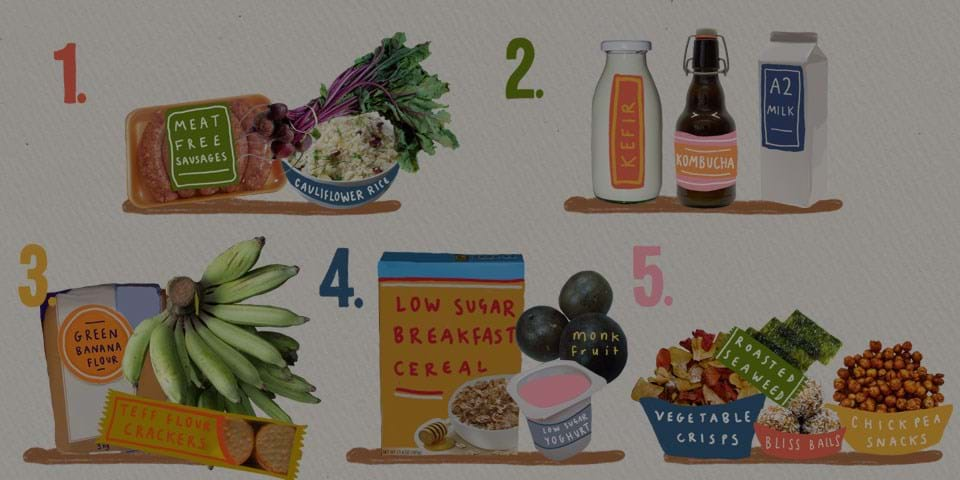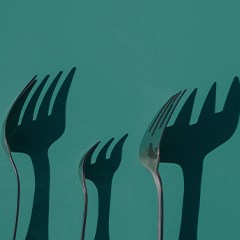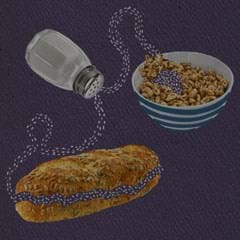If you’re a fan of food on Instagram (and who isn’t) you will be familiar with the trend of bowl food: gorgeously arranged, colorful meals – usually including avocado, often including kale – promoted as the latest in health-giving goodness.
Poké places, raw food cafes and salad bars let you happily create a beautiful bowl, brimming with healthy-looking goodies. Or you can throw together your own abundance-style salad bowl – they’re a great way to make leftover bits and pieces feel special, and they’re also excellent for getting a good range of vegetables into a lunch meal. Build it right, and a salad bowl meal can be a hearty, healthful and nutritious option.
But there are some traps when it comes to salads and bowls; traps that could mean we’re tricking ourselves thinking we’re eating a super-healthy option, when actually we’re not.
Just leaves
Man (and woman) cannot live on leaves alone. While we might think of a salad as being a big pile of green, this is not going to give us much in the way of satiety – that satisfying feeling of being just full enough. If your salad lunch is mainly leaves with a few other veges and a bit of chicken tossed through, you’re likely to be reaching for snacks to calm the hangry within a couple of hours. So when it comes to a salad bowl, make sure you balance it as you would any meal: include some healthy carbohydrate, a good amount of protein and half a plate of colorful vegetables, along with a little healthy fat (likely in the form of dressing). The ideal salad will have texture as well as flavor; so think about a few nuts and seeds for satisfying crunch, and some firmer veges like beans or broccoli.
Carb overload
Poké bowls are based on a grain – usually rice. Bonus points if you can get brown rice – this adds a bit of extra fiber – but keep an eye on the serving size. Some of the poké bowls I’ve tried have featured close to a cup of rice; a serving that would be fine for a big guy in a physical job, but far too much for a woman who spends most of her day sitting down. (A cup of cooked brown rice has 256 calories; over half what I’d want to eat for lunch. It also has 53g carbs). Some carbohydrate is important in a meal – but look to keep rice servings around half a cup or so. A good option with poké is to ask for half salad, half rice. With other grains – think whole grains such as quinoa, bulgur, buckwheat or teff – the same rule applies.
Too much topping
A salad or bowl meal can be brimming with healthful ingredients, but it can be a health blowout if we don’t take care with what we put on top. Oil-based dressings are fine, but keep in mind they’re energy-dense; in other words, they pack a lot of calories into a small serving. A tablespoon of a standard vinaigrette has about 100 calories; that’s the same as a large banana (which you probably wouldn’t put on your salad). Poké bowls often feature creamy, mayo-based dressings. Again there’s nothing really inherently unhealthy about these (although some might be overly salty) but they pack a punch energy-wise. So can some of the toppings on offer; a few nuts are good but watch out for the deep-fried shallots, corn chips and other crispy bits that are sometimes on offer. You don’t have to avoid dressing and toppings altogether. Some healthy fats are good, and important, in your bowl. I’d steer clear of coconut chips and flakes though, which are high in energy and saturated fat.
Avocado bounty
There’s no doubt a beautiful fan of avocado makes a bowl look Insta-awesome. Avocados are great food, and totally delicious. When they’re abundant and cheap, make the most of the avos. But as well as being full of satisfying fiber, healthy fat and other goodness, they are unique in the fruit world for being high in energy. If you’re looking to keep your lunch light, keep the avo serve moderate. I love mixing avocado into plain yoghurt to make a dressing; this gives a lovely avocado creaminess with less richness.
Niki Bezzant is a New Zealand-based food writer, editor and commentator. She is the founding editor (now editor-at-large) of Healthy Food Guide magazine, and is currently president of Food Writers New Zealand and a proud ambassador for the Garden to Table program which helps children learn how to grow, cook and share food. She is a member of the Council of Directors for the True Health Initiative, a global coalition of health professionals dedicated to sharing a science-based message of what we know for sure about lifestyle and health.
If you want more health and fitness inspiration simply sign up to Fit Planet and get the freshest insights and advice straight to your inbox.








